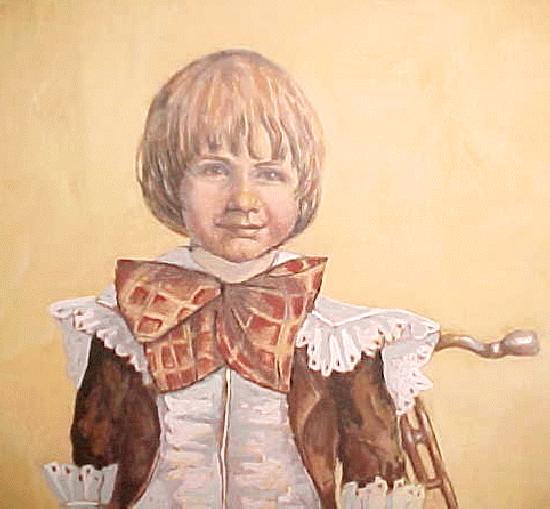
Little Lord Fauntleroy Suits: Classic Period Colors--Shades

Figure 1.--This undated portrait shows an Ameeican boy wearing a brown Fauntlerouy suit. The drawing of the suit and blouse is very accurate. The portrait looks rather modern, especially the boy's hair style which look like the 1970s. One reader writes, "I'd guess that was a modern image from a costume guide or childrens history book. (It was actually a framed print signed by Joanne Thompson.)
|
Fauntleroy suits were made in many colors and materials and with a variety of features and embelishments. The classic Fauntleroy suit was black or dark blue. Later other dark
colors appeared like burgandy or forrest green. We know suits were made in these colors because many wealthy families had portraits painted. Brown seems an especially popular choice, although we are still assessing the relative popularity of the differing colors and shades. Also fashion magazines during the period noted these colors, notably the velvet suits were usually dark colors. Many catalogs provide details as to the colors and materials in which these suits were made. We do not yet know if these different colors varied over time or among countries.
Shades
While black was clearly the most common color, we note several colorted suits also being worn. We are still assessing the relative popularity of the differing colors and shades.
Black
The classic Fauntleroy suit was black or dark blue. We know suits were made in these colors because many wealthy families had portraits painted.
Blue
We believe that the vlue suits were primarily earher dark shades.
Brown
Brown seems an especially popular choice. Brwn apperars to have been worn in different shadesm, bith satl and medium shades.
Burgandy
We believe that the first Little Lord Fauntleroy sduits were black and later other dark
colors appeared like burgandy or forrest green. This time line, however, needs to be reserached more fully.
Green
We nbote some dark forrest green Faunrleroy suits.
Grey
White
We have not note boys wearing white Little Lord Faintleroy suits, although after the turn of the 20th century various white outfits such as white tunic suits became popular.
Sources of Information
The black and white photography of the day ofered few clues as to color. Some photiographs were coliorized. We beliecve that the correct colors were isually ised in these colorzations, although we cannot be positive. We know suits were made in these colors because many wealthy families had portraits painted. Also fashion magazines during the period noted these colors, notably the velvet suits were usually dark colors. Many catalogs provide details as to the colors and materials in which these suits were made.
Chronological Trends
We do not yet know if these different colors varied over time.
Country Trends
We do not yet know if these different colors varied among countries.
Christopher Wagner

Fauntleroy Related Pages:
[Return to the Classic Fauntleroy suit color page]
[Return to theMain Fauntleroy page]
[Edwardian Fauntleroy suits]
[Final Fauntleroy period]
[Fauntleroy dresses]
[Lace collars]
[Vivian Benett]
[Fauntleroy patterns]
Other Related Pages:
[Dresses]
[Kilts]
[Smocks]
[Pinafores]
[Sailor Hats]
[Blouses]
[Ring Bearers]
[Long hair]
[Ringlet curls]
[Hair bows]
[Bangs]
[Collars]
[Bows]
Navigate the Boys' Historical Clothing Web Site:
[Introduction]
[Activities]
[Biographies]
[Chronology]
[Clothing styles]
[Countries]
[Bibliographies]
[Contributions]
[FAQs]
[Glossaries]
[Satellite sites]
[Tools]
[Boys' Clothing Home]
Created: September 30, 2002
Last updated: September 30, 2002



